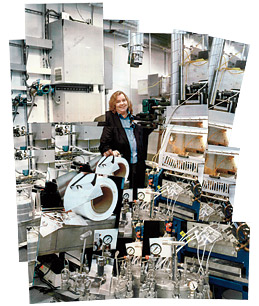
President and CEO of Zink, Wendy Caswell's mosaic portrait was assembled from numerous inkless Zinks.
Printer ink is easy to hate. It's messy and costly, and it runs out right when you need it most. Some printer manufacturers have tried to build more ink-efficient models; other companies sell off-label refill ink so you can reuse cartridges. But a start-up called Zink (short for "zero ink") has a bolder solution: How about getting rid of the ink entirely?
Zink's trick is to encode paper with billions of dye crystals. To produce pictures, a print head emits heat pulses that melt the dye crystals, rendering them into the desired colors. Zink is betting on the magic of that inkless process — a process protected by some 100 patents and pending patents. The company, based in Bedford, Mass., is so confident of its intellectual property that it isn't even making its own machines. Instead, Zink is modeling itself on Microsoft and Intel, licensing its technology for use in other manufacturers' devices. Why battle Canon, Epson and Lexmark when they could become your customers instead? "If Intel were captive to one brand, it never would have become the great brand it became," says Zink ceo Wendy Caswell. "The same goes for Microsoft."
Like those two giants, Zink could see its technology used in a diverse array of gadgets — from digital picture frames to cameras to laptops. And that doesn't even include cell phones, which Americans use to take about 10 billion pictures each year — only about 10% of which ever end up being printed. "This allows you to put printers where they have never gone before," says Caswell. Zink could eventually be used by professionals in construction, real estate and other fields in which instant pictures are often essential.
In July, Polaroid, reborn out of the ashes of a 2001 bankruptcy, put the new technology to work, releasing PoGo, the first Zink portable printer. The $150 device is a little bigger than an iPod and prints sticker-backed miniatures 2 in. by 3 in. (5 cm by 8 cm). The PoGo connects to digital cameras through a usb cable and to cell phones through Bluetooth. Polaroid, which also makes digital cameras and picture frames, plans to incorporate Zink into some existing products and produce larger printers for commercial applications. "This is not going to be a one-hit wonder," says Polaroid's director of product development, Jonathan Pollock.
Like many version 1.0 products, the PoGo has several failings. Photo quality is mediocre, and Zink paper costs $10 for 30 prints. The device isn't as fast as you might expect: it takes a minute or two to transmit images wirelessly to the device and an additional 45 seconds to print. And the PoGo isn't yet compatible with some popular devices like Apple's iPhone. Jim Lyons, a columnist for the Hard Copy Observer, an industry newsletter, raises the concern that portable printers may have limited appeal among those who grew up in the digital era. "The question is whether younger consumers are content to share photos online without printing them. I'm inclined to think that there's a generational shift," says Lyons. "But even if printing takes place in a small subset of cases, that still means millions of prints."
Like most start-ups, Zink has wrestled with growing pains. When the company received its first set of paper packs from a packager, some had the wrong number of sheets. Rather than send the sets back, Caswell put 30 employees on an assembly line to weigh the 30,000 packages and fix the lemons. Chemists, engineers and others along the corporate ladder chipped in. "Everybody does the dishes here," Caswell says. But if Zink technology catches on, the same employees could be dining out soon.